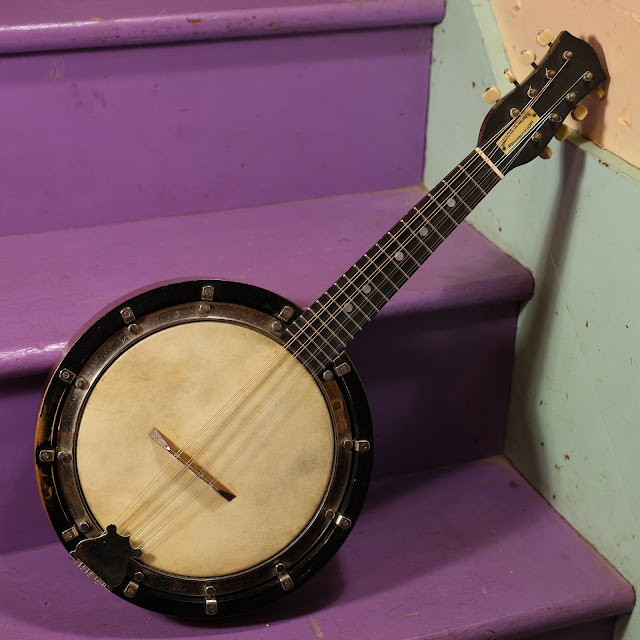1920s Beare & Sons Perfection Banjo-Mandolin
UK-made banjos (like this one) of all sorts often feature the Euro-centric rim construction seen on this banjo-mando. The Brits had been using it since the 1880s on "zither banjo" 5-strings. The head is basically "clamped" via bolts between two pieces of steel to set tension and then this flat rim is set on a round, thick-walled resonator that forms the body. It's a smart design that's efficient and lighter-weight overall than using a separate tonering and then a ton of hook/nut/shoe hardware, but it means that the head's diameter (and thus bass response) is limited by having to be a little smaller than whatever rim/resonator supports it. It also just sounds different.
This one's marked Beare & Sons and it's nicer-quality than the average UK-sourced instrument for the time. The neck is somewhat-figured walnut and the veneer on the back of the resonator/rim is awfully pretty. It has nicely-buttoned tuners and crisply-cut corners and headstock details.
Soundwise, these are direct and forward-sounding with a bit of a "clop-clop" horsey-stepping sound to them. It's hard to explain, but that sound is awesome for crosspicking or modal tunings. These have a mild "reverb" effect from the rim design, but damping of the string afterlength keeps the notes fundamental.
Repairs included: a fret level/dress, additional screw attachment for the neck joint to keep it stable, side dots install, cleaning, modification (added compensation) of the original bridge, and a setup.
Setup notes: action is spot-on at 1/16" at the 12th fret and it's strung with 32w-9 gauges (GHS A240 set). The neck is straight and the frets still have good life left in them post-leveling.
Condition notes: it's clean overall but does show usewear in some faded black to the finish on the top of the rim and on the back of the neck and on the fretboard. It's entirely original, too.
It comes with: its original chip case.
This one's marked Beare & Sons and it's nicer-quality than the average UK-sourced instrument for the time. The neck is somewhat-figured walnut and the veneer on the back of the resonator/rim is awfully pretty. It has nicely-buttoned tuners and crisply-cut corners and headstock details.
Soundwise, these are direct and forward-sounding with a bit of a "clop-clop" horsey-stepping sound to them. It's hard to explain, but that sound is awesome for crosspicking or modal tunings. These have a mild "reverb" effect from the rim design, but damping of the string afterlength keeps the notes fundamental.
Repairs included: a fret level/dress, additional screw attachment for the neck joint to keep it stable, side dots install, cleaning, modification (added compensation) of the original bridge, and a setup.
Setup notes: action is spot-on at 1/16" at the 12th fret and it's strung with 32w-9 gauges (GHS A240 set). The neck is straight and the frets still have good life left in them post-leveling.
Scale length: 13 1/8"
Nut width: 1 1/4"
String spacing at nut: 1 1/16"
String spacing at bridge: 1 1/2"
Head diameter: 8"
Rim diameter: 10 1/2"
Rim diameter: 10 1/2"
Rim depth: 2 1/4"
Rim material: unknown, maple?
Neck wood: walnut, lightly figured
Fretboard: ebonized maple
Bridge: original rosewood or mahogany with fret saddle, now compensated
Neck feel: deep/bigger V-shape, flat board
Condition notes: it's clean overall but does show usewear in some faded black to the finish on the top of the rim and on the back of the neck and on the fretboard. It's entirely original, too.
It comes with: its original chip case.
How about those bone-buttoned tuners?
The contrasting rosewood/mahogany-veneer back is really nice.
















Comments
I emailed Glen of the Banjo Museum- he has sold me a Windsor (German made) mandolin and the Windsor Whirle motif- which I needed for my 1927 Windsor tenor guitar- that looks like an Epiphone Recording series instrument but my guy tells me, was made in Czechoslovakia or Saxony. Windsor sold another model that was made by Ermelinda Silvestri in Catania, Sicily. Anyway, he thinks it is part UK made, which is what you suggest- George Houghton. This is what Glen tells me:
I have done a couple of this type, they are confusing, they are English assembled, the z brackets are English pot and bezel, I favour George Houghton he had his finger in so many pies, he also did the Bell line which are quite similar- once set up they play really well, the pots reassemble the Windsor 42 banjo pots. George and Arthur Windsor were not far from each other and both were keen business men, Windsor imported mandolins from Italy, Austria but they were plainly different.
Birmingham at that time was the tool box of the world and a few friends and I think most of the hooks nuts casting were made in Birmingham, which would have been called on by different manufacturers,
Windsor preferred the BA threads on his gear, others Whitworth and so on.
Americans AF No 8